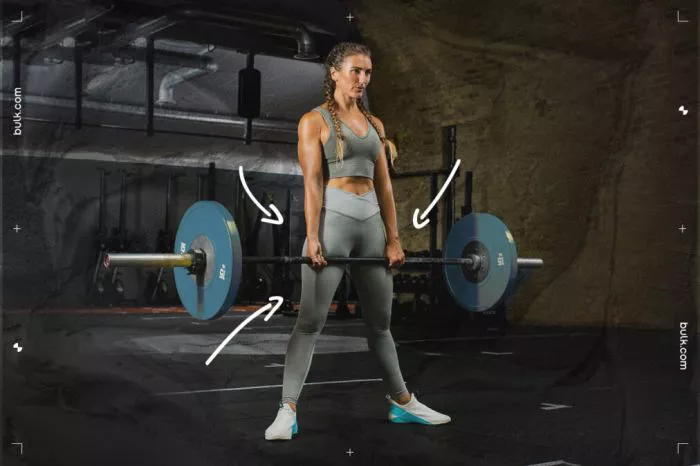Deadlifting is a highly effective compound exercise that targets multiple muscle groups, including the legs, glutes, lower back, and core. It is a staple in strength training programs for both men and women, offering numerous benefits such as increased strength, improved posture, and enhanced overall athleticism. However, many women may feel intimidated or unsure about incorporating deadlifts into their workout routine due to misconceptions about the exercise or concerns about injury. In this article, we’ll explore six tips to help women perform deadlifts safely and effectively, maximizing their benefits and confidence in the gym.
1. Master Proper Form and Technique:
The key to safe and effective deadlifting for women (and men) lies in mastering proper form and technique. This includes maintaining a neutral spine throughout the movement, engaging the core muscles, and using the legs and hips to drive the lift. Improper form can increase the risk of injury and limit the effectiveness of the exercise.
Solution: Start by practicing the hip hinge movement pattern, which is essential for performing deadlifts correctly. Stand with your feet hip-width apart, knees slightly bent, and hinge at the hips while keeping your back straight and chest up. Imagine pushing your hips back as if closing a car door with your butt. As you lower your body, keep the barbell close to your shins, and maintain tension in your core and hamstrings. Practice this movement pattern with light weight or no weight until you feel comfortable with the technique.
2. Begin with Light Weight:
When starting out with deadlifts, it’s essential to begin with light weight to focus on mastering proper form and technique. Many women may feel tempted to lift heavy weights right away, but this can lead to poor form and increased risk of injury. Starting with lighter weights allows you to build a strong foundation and gradually progress over time.
Solution: Begin with an empty barbell or a pair of dumbbells to practice the deadlift movement pattern without added resistance. Focus on maintaining proper form and technique throughout each repetition, paying attention to your body positioning, and alignment. As you become more comfortable with the movement, gradually increase the weight in small increments to continue challenging yourself while maintaining proper form.
3. Warm Up Properly:
Warming up properly before deadlifting is crucial for preparing your muscles and joints for the demands of the exercise. A thorough warm-up increases blood flow, improves flexibility, and reduces the risk of injury during the workout.
Solution: Start your deadlift workout with a dynamic warm-up that includes exercises such as leg swings, hip circles, bodyweight squats, and glute bridges to activate the muscles of the lower body and core. Perform light cardio exercises such as jogging or cycling to increase your heart rate and body temperature. Additionally, incorporate specific warm-up sets of deadlifts with light weight to prime your muscles and reinforce proper technique before lifting heavier loads.
4. Focus on Breathing and Core Engagement:
Proper breathing and core engagement are essential for maintaining stability and support during the deadlift. Many women may neglect to focus on their breathing and core activation, leading to loss of tension and potential injury.
Solution: Before initiating the lift, take a deep breath into your diaphragm and brace your core muscles as if you were preparing to be punched in the stomach. This intra-abdominal pressure creates a stable foundation for the lift and helps protect your spine. Maintain this braced position throughout the lift, exhaling forcefully at the top of the movement. Avoid holding your breath or allowing your core to relax during the lift, as this can compromise stability and increase the risk of injury.
5. Use Proper Footwear:
The right footwear can make a significant difference in your deadlift performance and safety. Wearing shoes with a flat, non-compressive sole provides a stable base and allows for proper foot positioning during the lift. Avoid wearing shoes with excessive cushioning or an elevated heel, as these can interfere with proper form and stability.
Solution: Opt for minimalist shoes or weightlifting shoes with a flat sole and firm grip to maximize stability and traction during the deadlift. Alternatively, deadlifting barefoot or in socks can also provide a stable base and enhance proprioception, allowing you to feel the ground and maintain proper alignment throughout the lift.
6. Listen to Your Body and Progress Gradually:
As with any exercise, it’s essential to listen to your body and progress gradually to avoid overtraining and injury. Pushing yourself too hard or lifting too heavy too soon can lead to muscle strain, joint pain, and other injuries.
Solution: Pay attention to how your body feels during and after each deadlift workout. If you experience any discomfort or pain, scale back the intensity or volume of your training and focus on recovery. Gradually increase the weight and volume of your deadlifts over time as your strength and confidence improve, but always prioritize proper form and technique above all else.
Conclusion:
Deadlifting is a highly effective exercise for women that can help build strength, improve posture, and enhance overall fitness. By mastering proper form and technique, starting with light weight, warming up properly, focusing on breathing and core engagement, using proper footwear, and listening to your body, women can perform deadlifts safely and effectively, maximizing their benefits and confidence in the gym. Incorporate these tips into your deadlift training routine to take your strength and fitness to the next level.
Related Topics:


